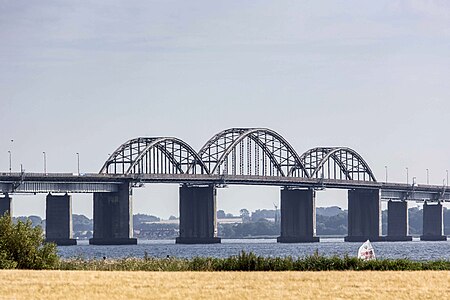Storstrøm Bridge
1937 establishments in DenmarkArch bridges in DenmarkBridges completed in 1937Bridges in DenmarkBuildings and structures in Guldborgsund Municipality ... and 7 more
Buildings and structures in Vordingborg MunicipalityCommons category link is locally definedPages with Danish IPARailway bridges in DenmarkRoad-rail bridgesRoad bridges in DenmarkTied arch bridges

The Storstrøm Bridge (Danish: Storstrømsbroen, pronounced [ˈstoɐ̯stʁɶmsˌpʁoˀn̩]) is a road and railway arch bridge that crosses Storstrømmen between the islands of Falster and Masnedø in Denmark. Together with Masnedsund Bridge it connects Falster and Zealand (Sjælland). It was the main road connection between the islands until the Farø Bridges were opened in 1985. It is still part of the railway connection between the islands of Lolland, Falster, and Zealand. It is on the rail line between Copenhagen and Hamburg, Germany.
Excerpt from the Wikipedia article Storstrøm Bridge (License: CC BY-SA 3.0, Authors, Images).Storstrøm Bridge
Storstrømsvej, Guldborgsund Municipality
Geographical coordinates (GPS) Address External links Nearby Places Show on map
Geographical coordinates (GPS)
| Latitude | Longitude |
|---|---|
| N 54.966111111111 ° | E 11.884722222222 ° |
Address
Storstrømsbroen
Storstrømsvej
4840 Guldborgsund Municipality
Region Zealand, Denmark
Open on Google Maps







